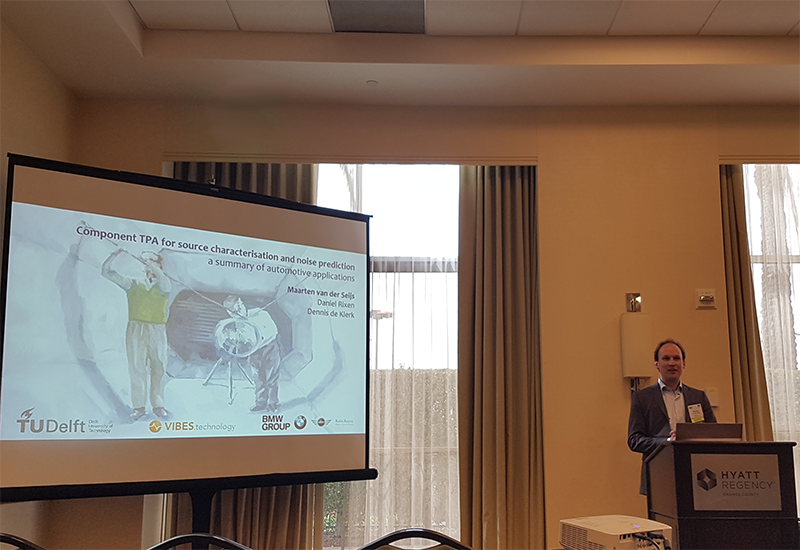COUPLE: Born @ IMAC
03 February 2022
COUPLE is our latest software project, but in some sense also our first one. Five years ago, at IMAC 2017, we introduced VIBES as a company with the ambition to make a standalone software application to perform hybrid Dynamic Substructuring. This year, we’ll be at IMAC again, proud to be announcing that the launch of the software, called COUPLE, will become reality in 2022!
VIBES is no stranger at IMAC: we have been going to every IMAC since we started and some of us for even longer! Often alongside or even in collaboration with the TU Munich, VIBES presented several research works at IMAC over the past years. This build-up of knowledge partially kick-started the COUPLE project.
At a certain point we applied, together with the TU Munich and BMW, for a European grant in order to realise our first ambition. A few months later, in November 2020, work on COUPLE could begin. In this project, the TU Munich supports us with methodology research (some results will be presented at this years IMAC, so be sure to look out for their presentation). Our technical partner, BMW, functions as our testing grounds. So it is thanks to them and to the contacts and knowledge we gained at IMAC that we’re now actually working on that goal to develop a standalone application for hybrid Dynamic Substructuring!
Hybrid Dynamic Substructuring
Let’s look into what hybrid Dynamic Substructuring is and what role software has in this perspective. In short, Dynamic Substructuring (DS) is a perception in dynamic modeling in which one sees a dynamic system as the sum of its parts. Essentially, it is a modular approach in dynamic modeling. This modularity benefits those applications in which the components are designed and constructed independently from one another before assembled in a team effort. And note, that this is the normal approach nowadays.
Hybrid DS is were some components are modeled by simulation and others are modeled through testing. This way you might get the best of both worlds. For those components that are best simulated we can obtain numerical models, and for those best tested –because they are overly complex or would simply take too long to design—you may obtain experimental models.
Where there are currently many software applications for dynamic simulation – by the very definition, experimental modeling does not yet have that privilege. In fact, experimental modeling is itself lagging behind in the field. Most people still regard tests as a validation step or use them to update existing numerical based models. This is actually one of the problems we ran into in our ambition to make this software. So in order to realise the goal of making COUPLE, we had to first make DIRAC, our standalone testing software used to create integral experimental models.
A change in workflow
The correct workflow in any given challenge is very much determined by the means available. Good software applications can influence our way of working. We see this shift happening through two main mechanisms: Software uncovers a new way of doing things, or it simplifies certain workflows.
Also COUPLE works through both mechanisms: COUPLE uncovers new ways of doing things, for instance we’ve build in a library that will store various models in the user’s domain. This means that, unlike before, models will no longer be one-time-use, but rather be used over and over. With models being so easily found and re-used, users will make these models with that in mind.
Second, like DIRAC, COUPLE will handle the various bookkeeping steps which is intrinsic to DS workflows. It will do this with intuitive overviews of the coupling process and will provide various checks and balances to make sure that any gross errors are avoided.
An example of simplifying workflows is COUPLEs ability to take care of mundane but nonetheless costly tasks. DS workflows are relatively long and errors seep in at every step. While this is true for both the experimental and numerical side of things, it is especially true for the experimental side since the processes are less standardized. With experiments, gross errors often occur in mundane, administrative tasks. Though often small, these errors take time and can be very costly. These sort of tasks can and should be covered by good software, hence: COUPLE.
A new way of working and a simplified, modular workflow to perform hybrid Dynamic Substructuring; a game changer is born, called COUPLE.
More COUPLE
This is just a hint of the emergence, purpose and workflow of COUPLE. If you’re interested in the full story and the demo, visit our presentation at the upcoming IMAC.
Conference: February 7–10, 2022
VIBES presentation: Wednesday, February 9, 2022 | 11:30 p.m. ET
More info:
Maarten van der Seijs
Maarten holds a PhD degree from the TU Delft on dynamic substructuring and as such is responsible for the technology within VIBES. Maarten co-founded VIBES when he came back to Delft from BMW in Munich, where he did his PhD research.
Steven Klaassen
Steven finished his PhD programme on experimental joint identification at the TU Munich. He works with the R&D team to translate academia to practical solutions and to keep innovating our method and software.

